Business Accounting 3 Portfolio Activities Assessment 1
Added on 2023-06-03
41 Pages4611 Words467 Views
Details of Assessment
Term and Year Time allowed Week 2, 3, 4, 5, 6 and 7
Assessment No 1 Assessment Weighting 40%
Assessment Type Portfolio of Activities
Due Date Week 2, 3, 4, 5, 6 and 7 Room TBA
Details of Subject
Qualification BSB40212 Certificate IV in Business
Subject Name Business Accounting 3
Details of Unit(s) of competency
Unit Code (s) and
Names
BSBFIA402 Report on financial activity
Details of Student
Student
Name
College Student ID
Student Declaration: I declare that the
work submitted is my own, and has not
been copied or plagiarised from any
person or source. Signature: ___________________________
Date: _______/________/_______________
Details of Assessor
Assessor’s Name
Assessment Outcome
Result
s Satisfactory Not Satisfactory Marks / 40
FEEDBACK TO STUDENT
Progressive feedback to students, identifying gaps in competency and comments on positive improvements:
______________________________________________________________________________________
______________________________________________________________________________________
______________________________________________________________________________________
______________________________________________________________________________________
Student Declaration: I declare that I have been
assessed in this unit, and I have been advised of my
result. I also am aware of my appeal rights and
reassessment procedure.
Signature: ____________________________
Date: ____/_____/_____
Assessor Declaration: I declare that I have
conducted a fair, valid, reliable and flexible
assessment with this student, and I have provided
appropriate feedback
Student did not attend the feedback session.
Feedback provided on assessment.
Signature: ____________________________
Date: ____/_____/_____
Business Accounting 3, Portfolio Activities, Assessment 1 v1.2, Last updated
on 20/03/2018 1
Term and Year Time allowed Week 2, 3, 4, 5, 6 and 7
Assessment No 1 Assessment Weighting 40%
Assessment Type Portfolio of Activities
Due Date Week 2, 3, 4, 5, 6 and 7 Room TBA
Details of Subject
Qualification BSB40212 Certificate IV in Business
Subject Name Business Accounting 3
Details of Unit(s) of competency
Unit Code (s) and
Names
BSBFIA402 Report on financial activity
Details of Student
Student
Name
College Student ID
Student Declaration: I declare that the
work submitted is my own, and has not
been copied or plagiarised from any
person or source. Signature: ___________________________
Date: _______/________/_______________
Details of Assessor
Assessor’s Name
Assessment Outcome
Result
s Satisfactory Not Satisfactory Marks / 40
FEEDBACK TO STUDENT
Progressive feedback to students, identifying gaps in competency and comments on positive improvements:
______________________________________________________________________________________
______________________________________________________________________________________
______________________________________________________________________________________
______________________________________________________________________________________
Student Declaration: I declare that I have been
assessed in this unit, and I have been advised of my
result. I also am aware of my appeal rights and
reassessment procedure.
Signature: ____________________________
Date: ____/_____/_____
Assessor Declaration: I declare that I have
conducted a fair, valid, reliable and flexible
assessment with this student, and I have provided
appropriate feedback
Student did not attend the feedback session.
Feedback provided on assessment.
Signature: ____________________________
Date: ____/_____/_____
Business Accounting 3, Portfolio Activities, Assessment 1 v1.2, Last updated
on 20/03/2018 1
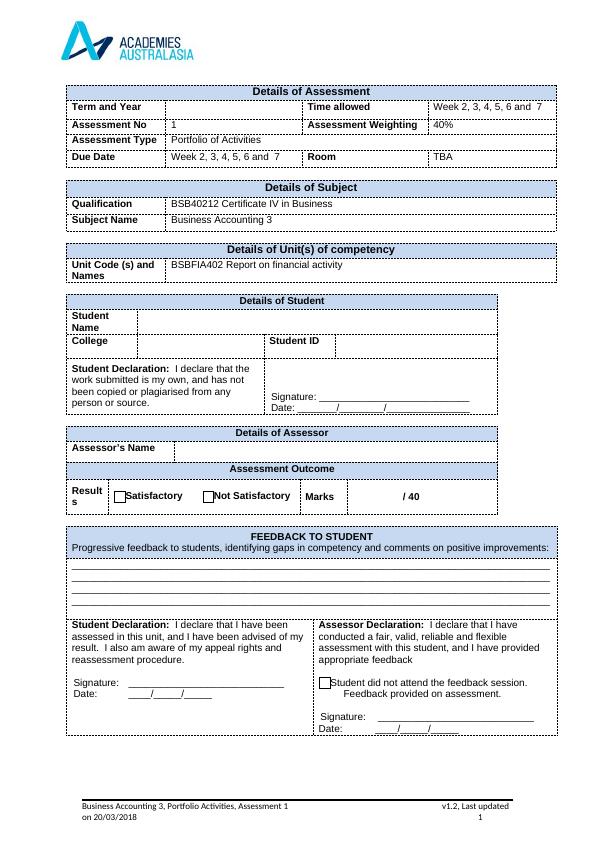
Purpose of the Assessment
The purpose of this assessment is to assess the
student in the following learning outcomes:
Satisfactory
(S)
Not yet Satisfactory
(NS)
Compile financial information and data
Prepare statutory requirement reports
Provide financial business recommendations
Assessment/evidence gathering conditions
Each assessment component is recorded as either Satisfactory (S) or Not Satisfactory (NS). A student can
only achieve competence when all assessment components listed under Purpose of the assessment section
are Satisfactory. Your trainer will give you feedback after the completion of each assessment. A student who
is assessed as NS (Not Satisfactory) is eligible for re-assessment.
Resources required for this Assessment
Upon completion, submit the assessment to your trainer along with assessment coversheet
Refer to the subject notes on E-Learning prior to responding to the tasks/questions
Any additional material will be provided by Trainer
Instructions for Students
Please read the following instructions carefully
This assessment has to be completed In class At home
The assessment is to be completed according to the instructions given by your assessor.
Feedback on each task will be provided to enable you to determine how your work could be improved.
You will be provided with feedback on your work within 2 weeks of the assessment due date. All other
feedbacks will be provided by the end of the term.
Should you not answer the questions correctly, you will be given feedback on the results and your gaps
in knowledge. You will be given another opportunity to demonstrate your knowledge and skills to be
deemed competent for this unit of competency.
If you are not sure about any aspects of this assessment, please ask for clarification from your
assessor.
Please refer to the College re-assessment and re-sit policy for more information.
Business Accounting 3, Portfolio Activities, Assessment 1 v1.2, Last updated
on 20/03/2018 2
The purpose of this assessment is to assess the
student in the following learning outcomes:
Satisfactory
(S)
Not yet Satisfactory
(NS)
Compile financial information and data
Prepare statutory requirement reports
Provide financial business recommendations
Assessment/evidence gathering conditions
Each assessment component is recorded as either Satisfactory (S) or Not Satisfactory (NS). A student can
only achieve competence when all assessment components listed under Purpose of the assessment section
are Satisfactory. Your trainer will give you feedback after the completion of each assessment. A student who
is assessed as NS (Not Satisfactory) is eligible for re-assessment.
Resources required for this Assessment
Upon completion, submit the assessment to your trainer along with assessment coversheet
Refer to the subject notes on E-Learning prior to responding to the tasks/questions
Any additional material will be provided by Trainer
Instructions for Students
Please read the following instructions carefully
This assessment has to be completed In class At home
The assessment is to be completed according to the instructions given by your assessor.
Feedback on each task will be provided to enable you to determine how your work could be improved.
You will be provided with feedback on your work within 2 weeks of the assessment due date. All other
feedbacks will be provided by the end of the term.
Should you not answer the questions correctly, you will be given feedback on the results and your gaps
in knowledge. You will be given another opportunity to demonstrate your knowledge and skills to be
deemed competent for this unit of competency.
If you are not sure about any aspects of this assessment, please ask for clarification from your
assessor.
Please refer to the College re-assessment and re-sit policy for more information.
Business Accounting 3, Portfolio Activities, Assessment 1 v1.2, Last updated
on 20/03/2018 2

Week 1:
Learningactivity1.1a–Chart of accounts
Complete
asearchontheInternetfortwoexamplesofachartofaccounts.Provideashortsummaryfore
achdetailingthesource ofyourexampleandwhatyoulearnt fromeachexample.
(1 Mark)
Example1–Source– GRAY ELECTRONICS REPAIR SERVICES
There is a unique coding system used whereby each
Account is given a unique account number this helps
In proper arrangement of the accounts.
Accounts grouped into categories.
respectively
Learningactivity1.2a–Identifyingaccounts
Business Accounting 3, Portfolio Activities, Assessment 1 v1.2, Last updated
on 20/03/2018 3
Assets (1000-1999)
Liabilities (2000-2999)
Owner’s equity (3000-3999)
Revenues (4000-3999)
Expenses (5000-5999)
Category 0- Fixed assets
Category 1- long-term and current assets
Category 2-Liabilities
Category 3-income accounts
Category 4-Trading expenses
Category 5-Selling and distribution
Category 6-Financial expenses
Learningactivity1.1a–Chart of accounts
Complete
asearchontheInternetfortwoexamplesofachartofaccounts.Provideashortsummaryfore
achdetailingthesource ofyourexampleandwhatyoulearnt fromeachexample.
(1 Mark)
Example1–Source– GRAY ELECTRONICS REPAIR SERVICES
There is a unique coding system used whereby each
Account is given a unique account number this helps
In proper arrangement of the accounts.
Accounts grouped into categories.
respectively
Learningactivity1.2a–Identifyingaccounts
Business Accounting 3, Portfolio Activities, Assessment 1 v1.2, Last updated
on 20/03/2018 3
Assets (1000-1999)
Liabilities (2000-2999)
Owner’s equity (3000-3999)
Revenues (4000-3999)
Expenses (5000-5999)
Category 0- Fixed assets
Category 1- long-term and current assets
Category 2-Liabilities
Category 3-income accounts
Category 4-Trading expenses
Category 5-Selling and distribution
Category 6-Financial expenses
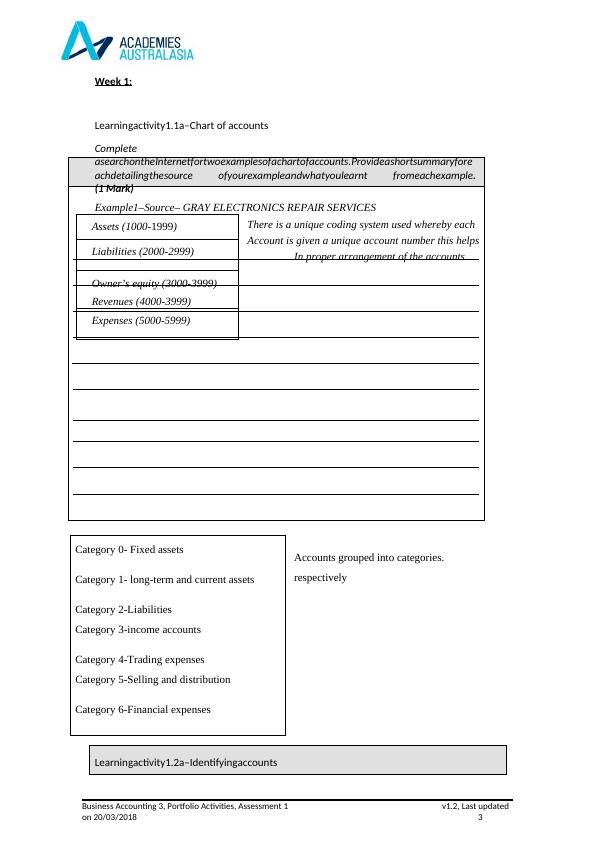
UsingthetwoexamplesyousourcedinActivity1.1
providetwoexamplesofanaccountdetailedforeachaccountlistedbelow.
(1 mark)
Assetaccounts Incomeaccounts
1.cash
2. Furniture and fittings
1. Accounts receivable
2. Interest receivable
Liabilityaccounts Expenseaccounts
1. Accounts payable
2. Salaries receivable
1. Rent expense
2. Interest expense
Learningactivity1.3a–Organizingandcodingaccounts (2marks)
Organizethefollowingaccountsin toachart ofaccounts and thencodeeachaccount.
stafftraining
ownercapital
income–
salesofgoodsandservices
accountspayable
pettycashaccount
freight
salariesandwages.
officeEquipment
companyownedvehicles
motorvehicleexpenses
ANZbankloan
Business Accounting 3, Portfolio Activities, Assessment 1 v1.2, Last updated
on 20/03/2018 4
providetwoexamplesofanaccountdetailedforeachaccountlistedbelow.
(1 mark)
Assetaccounts Incomeaccounts
1.cash
2. Furniture and fittings
1. Accounts receivable
2. Interest receivable
Liabilityaccounts Expenseaccounts
1. Accounts payable
2. Salaries receivable
1. Rent expense
2. Interest expense
Learningactivity1.3a–Organizingandcodingaccounts (2marks)
Organizethefollowingaccountsin toachart ofaccounts and thencodeeachaccount.
stafftraining
ownercapital
income–
salesofgoodsandservices
accountspayable
pettycashaccount
freight
salariesandwages.
officeEquipment
companyownedvehicles
motorvehicleexpenses
ANZbankloan
Business Accounting 3, Portfolio Activities, Assessment 1 v1.2, Last updated
on 20/03/2018 4

GSTcollected
ANZbank account
inventory
ANZbankaccountinterest–received
Asset account
Current Assets Account code (1000-1999)
Petty cash account 1000
Inventory 1010
ANZ bank account 1020
Non -Current Assets Accountcode (2000-2999)
Office equipment 2000
Company-owned vehicles 2010
Owner’s Equity Account code (3000-3999)
Owner’s capital 3000
Liability account Account code (4000-4999)
Accounts payable 4000
ANC bank loan 4010
Business Accounting 3, Portfolio Activities, Assessment 1 v1.2, Last updated
on 20/03/2018 5
ANZbank account
inventory
ANZbankaccountinterest–received
Asset account
Current Assets Account code (1000-1999)
Petty cash account 1000
Inventory 1010
ANZ bank account 1020
Non -Current Assets Accountcode (2000-2999)
Office equipment 2000
Company-owned vehicles 2010
Owner’s Equity Account code (3000-3999)
Owner’s capital 3000
Liability account Account code (4000-4999)
Accounts payable 4000
ANC bank loan 4010
Business Accounting 3, Portfolio Activities, Assessment 1 v1.2, Last updated
on 20/03/2018 5
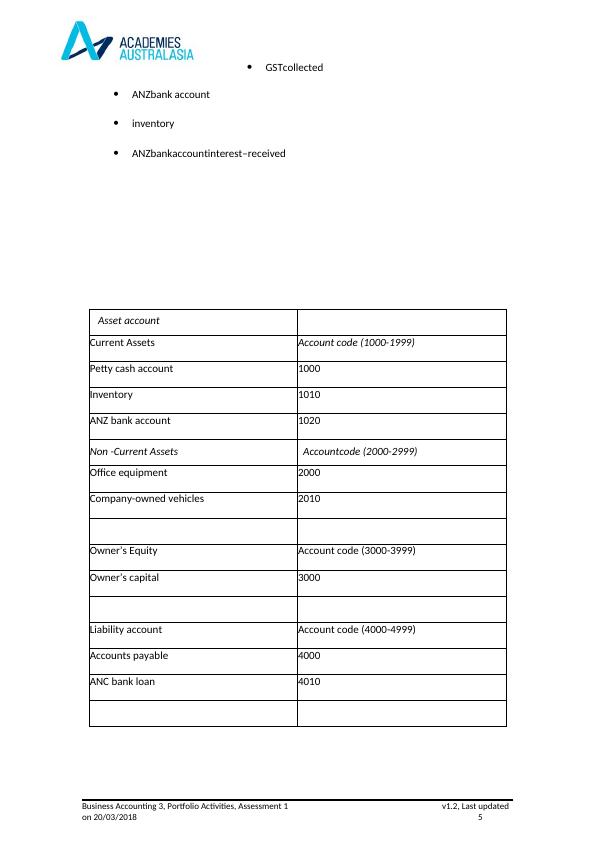
Business Accounting 3, Portfolio Activities, Assessment 1 v1.2, Last updated
on 20/03/2018 6
on 20/03/2018 6

Incomeaccount Accountcode (5000-5999)
Income sale of goods and services 5000
ANZ bank account interest received 5010
Expenseaccount Accountcode (6000-6999)
Staff training 6000
Salaries and wages 6010
Freight 6020
Motor vehicle expenses
GST collected
6030
6040
Business Accounting 3, Portfolio Activities, Assessment 1 v1.2, Last updated
on 20/03/2018 7
Income sale of goods and services 5000
ANZ bank account interest received 5010
Expenseaccount Accountcode (6000-6999)
Staff training 6000
Salaries and wages 6010
Freight 6020
Motor vehicle expenses
GST collected
6030
6040
Business Accounting 3, Portfolio Activities, Assessment 1 v1.2, Last updated
on 20/03/2018 7
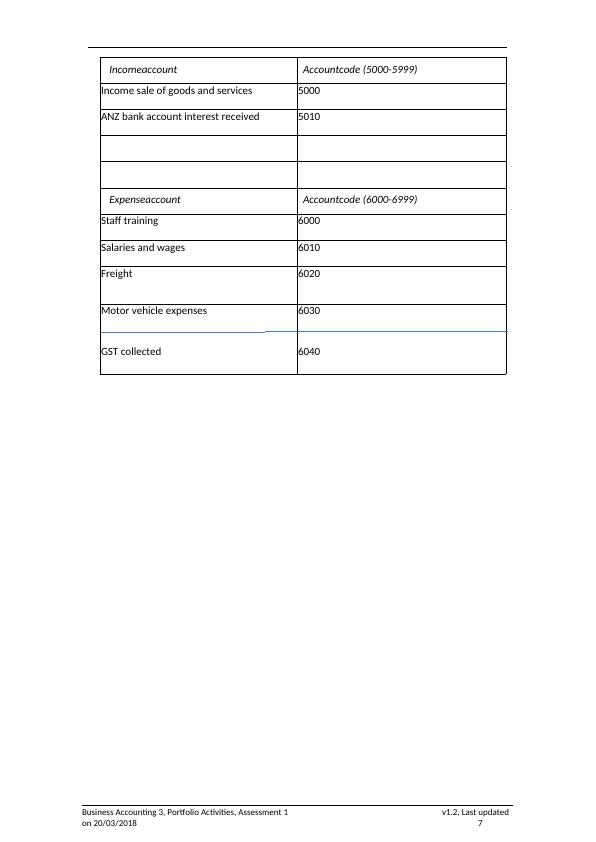
Week 2:
Learningactivity2.1a–Assetandliabilityvaluations
Whatisthedifferencebetweencurrentandnon-currentassets?(1 mark)
Current assets are the assets which can be converted to cash easily and are used to fund
the on-going operations of the company and pay the current expenses while non-current
assets are fixed assets that have a useful life of more than a year and cannot be easily
converted into cash.
Business Accounting 3, Portfolio Activities, Assessment 1 v1.2, Last updated
on 20/03/2018 8
Learningactivity2.1a–Assetandliabilityvaluations
Whatisthedifferencebetweencurrentandnon-currentassets?(1 mark)
Current assets are the assets which can be converted to cash easily and are used to fund
the on-going operations of the company and pay the current expenses while non-current
assets are fixed assets that have a useful life of more than a year and cannot be easily
converted into cash.
Business Accounting 3, Portfolio Activities, Assessment 1 v1.2, Last updated
on 20/03/2018 8
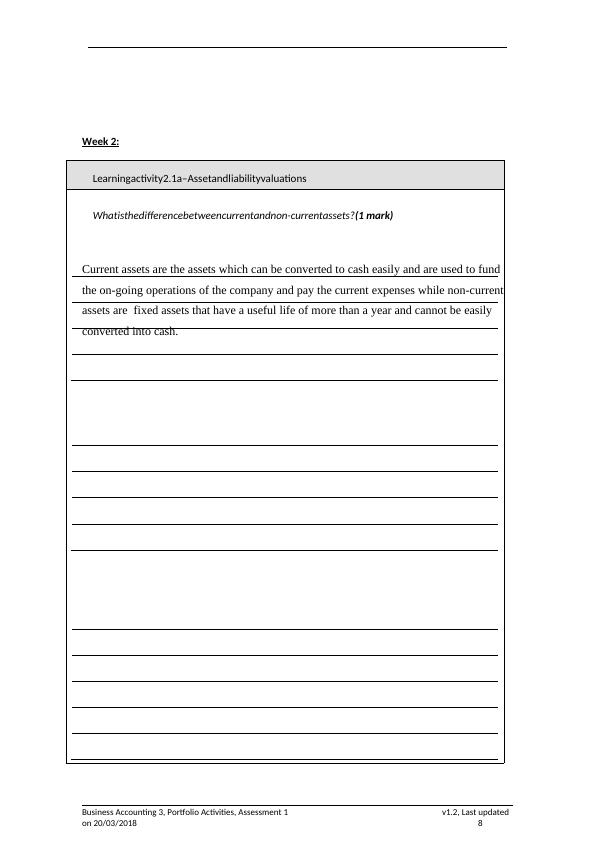
End of preview
Want to access all the pages? Upload your documents or become a member.
Related Documents
BSBFIM501 Diploma of Leadership and Managementlg...
|11
|2741
|112
Instructions Given by your Assessorlg...
|22
|2338
|307
BSBINM501 Manage An Information Or Knowledge Management Systemlg...
|7
|1728
|43
BSBINN601 Lead and Manage Organisational Changelg...
|40
|8755
|1486
Accounting & Budgeting Assessment No. 1lg...
|46
|10474
|359
BSBFIA402 Report on Financial Activitylg...
|6
|1519
|171
